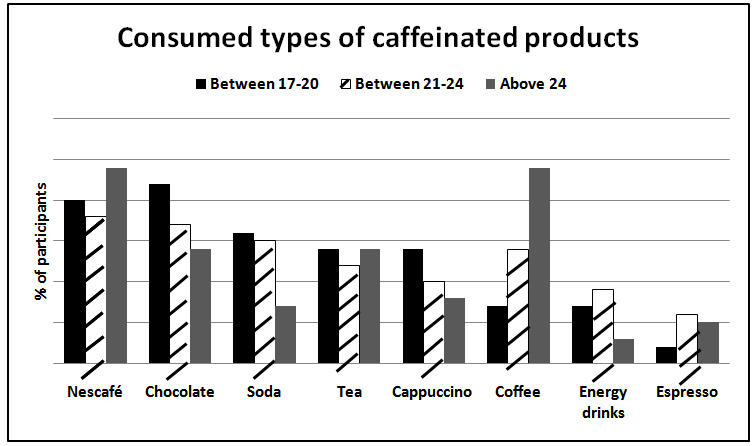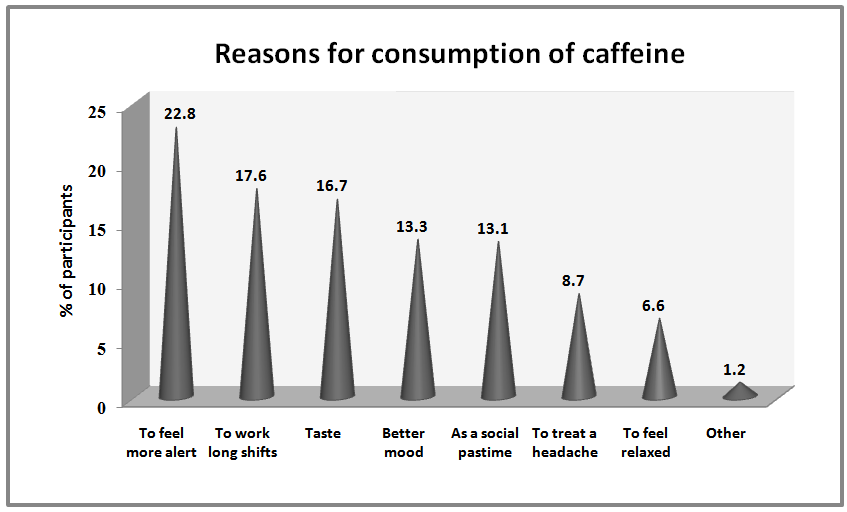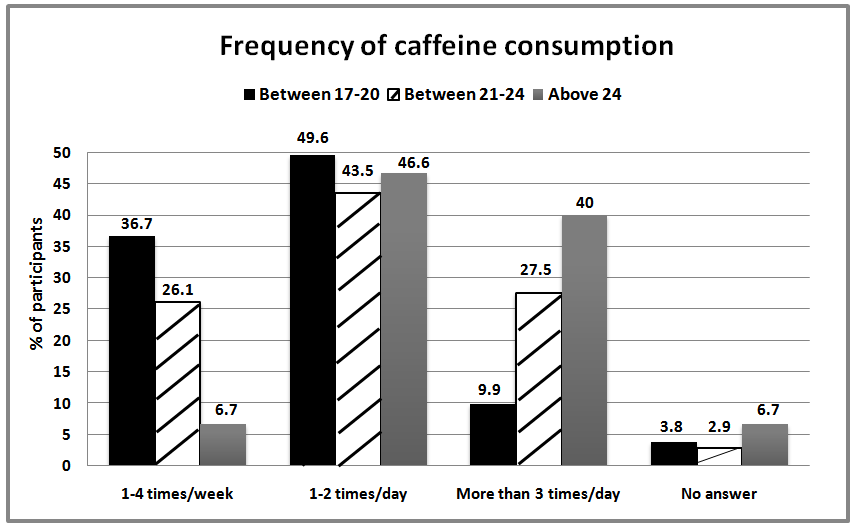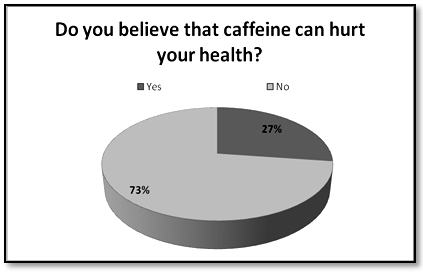-
Paper Information
- Next Paper
- Previous Paper
- Paper Submission
-
Journal Information
- About This Journal
- Editorial Board
- Current Issue
- Archive
- Author Guidelines
- Contact Us
Public Health Research
p-ISSN: 2167-7263 e-ISSN: 2167-7247
2014; 4(5): 173-178
doi:10.5923/j.phr.20140405.04
Prevalence of Caffeinated-beverage Consumption by University Students in North Lebanon
Marie Tannous, Yara Al Kalash
Department of Sciences, Faculty of Natural and Applied Sciences, Notre Dame University-Louaize, Barsa, Lebanon
Correspondence to: Marie Tannous, Department of Sciences, Faculty of Natural and Applied Sciences, Notre Dame University-Louaize, Barsa, Lebanon.
| Email: |  |
Copyright © 2014 Scientific & Academic Publishing. All Rights Reserved.
Owing to our imposed new lifestyle, stress is commonly reduced by relying on several addictive substances such as caffeine, and similar other habit forming drugs. Caffeine is the most consumed psychoactive culprit, especially among university students and adults. There has been a lengthy debate concerning whether caffeine has a positive or negative impact on our health. This study aims to assess the prevalence of caffeinated-beverage consumption and its different sources among local university students by means of pre-tested questionnaire. Our subjects provided various reasons for their caffeinated-beverage consumption such as 22.8% to feel more alert, 17.6% to work long shifts and 16.7% simply just for the taste. Major contributors to caffeine intake among our population were Nescafe 19.7%, chocolate 19.2% and soft drinks 15.3%. During exams, 63% of our university students tend to increase their caffeine consumption in order to tolerate the high academic stress. The prevalence of caffeinated-beverage consumption was higher for third and fourth year university students (65.1%) compared to first and second year students (34.9%). Our study demonstrated that 97% of our North Lebanese university students consume a high level of caffeinated drinks without clearly understanding its possible side effects. Efforts should be exerted to decrease the amount of caffeinated-beverage consumption, and increase the awareness of this harmful substance.
Keywords: Caffeinated-beverages, Academic stress, University students, Lebanon
Cite this paper: Marie Tannous, Yara Al Kalash, Prevalence of Caffeinated-beverage Consumption by University Students in North Lebanon, Public Health Research, Vol. 4 No. 5, 2014, pp. 173-178. doi: 10.5923/j.phr.20140405.04.
1. Introduction
- In our daily lives, we are vulnerable to a broad range of chemicals and capable of absorbing harmful substances from foods, drinks, medications, and even from the environment [1]. Caffeinated-beverages are among the most frequently imbibed beverages by teenagers and adults due to their mentally stimulating effects. Caffeine, being the most coveted drink in the world [2], is a chemical substance that passes through the blood-brain barrier and stimulating the nervous system [3] by modulating the activity of many neurotransmitters and neuromodulators, including dopamine and acetylcholine in various brain areas [4, 5, 6, 7]. Caffeine belongs to the family of alkaloids that also includes a variety of compounds, such as: tea, cocoa, chocolate, cola nuts, energy drinks, pain relievers and other drugs [8]. Moreover, it is well known that powerful antioxidants named Polyphenols are found in caffeine [9]. Caffeine is both water and fat soluble and is quickly distributed in the body after absorption mainly by the small intestine and the stomach [10]. A recent study showed that, after its assimilation, caffeine is immediately diffused over the whole organism and has been discovered in many body fluids [1]. For many years, it has been doubtful whether caffeine consumption is good or bad on human health. Some people consume caffeinated products as a boost of energy, to feel more alert, improve their mood and work long shifts. Despite the multiple benefits of caffeine on the human body, many experiments were conducted to study its effects; they uncovered a number of side effects, such as: anxiety, lack of sleep, nervousness, cardiac arrhythmia and hypertension [11]. Previous cross-sectional study showed participants using caffeine for diverse reasons: academic purposes, social consumption and preference for the taste. Furthermore, among these participants, a few suffer from hot flushes, while others become aggressive due to heavy caffeine consumption [12]. Other stated that coffee drinking might add years to life span [9]. A previous study in North America revealed that coffee and tea are the major sources of caffeine in the adult diet, whereas caffeinated soft drinks and chocolate are the major sources of caffeine in a children’s diet [8].University students are exposed to academic stress due to their daily academic load [13]. As a result of their overwhelming stressful situations, students tend to cope by consuming caffeinated beverages [14]. The scarcity of information concerning the prevalence of caffeine intake among young adults, particularly university students in developing countries, led us to investigate local university students in North Lebanon for their caffeinated-beverage consumption, sources of the consumed caffeine, and the latent association between academic stress and the increase in consumption of caffeinated beverages.
2. Methodology
- A cross-sectional study was carried out on a target population that included three local universities. A total of 215 undergraduate and graduate students aged 17 years old and above, voluntarily responded to the questionnaire after a small introduction informing the participants about the goals and the application of this study. Data was collected by means of an anonymous, self-administered questionnaire available in English and Arabic. Questions were designed to satisfy the research questions as set forth in the introduction of this study. Therefore, the questionnaire was considered to have content validity. In addition to demographic details, information regarding different types of caffeinated products and frequency of consumption, the questionnaire included multiple-choice questions concerning the benefits and side effects of caffeine. Participation was voluntary. Participants were provided with the opportunity to ask questions on matters unclear to them. One of the limitations of the study was the fact that it was impossible to calculate the exact quantity of caffeine ingested by individual participants, as they prepared their consumed caffeinated beverages in fluctuating dosages. Consequently, this work compared the caffeine use of each year group by relating the percentage of use for academic purposes to the frequency of use.This study was mainly based on primary data by means of questionnaires and direct observation and discussion with students. Data entry and analysis were performed using Microsoft Office Excel 2010.
3. Results
- As mentioned above, the data for our study was gathered from three different universities located in North Lebanon; the students were restricted to adults more than 17 years of age. Our subjects consisted of a total of 68.8% females and 31.2% males. Among the participants, 60.9% were between the ages of 17-20, 30.1% were between the ages of 21-24 and 9% were aged above 24. Figure 1 shows the distribution of caffeinated beverage consumption among all the three age groups. The vast majority of the participants (97%) stated that they ingested caffeinated beverages; of these, 19.7% consumed Nescafé, 19.2% consumed chocolate, 15.3% consumed Soda, 13.6% consumed tea, 12.4% consumed cappuccino, 9.8% consumed coffee, 6.7% consumed energy drinks and only 3.3% consumed espresso. The three age groups differed slightly with regard to the sources of caffeinated beverages.
 | Figure 1. Types of caffeinated products as selected by the three age groups |
 | Figure 2. Reasons for the consumption of caffeine as selected by all participants |
 | Figure 3. Frequency of caffeine consumption by the three age groups |
 | Figure 4. Distribution of withdrawal symptoms and signs of caffeine among all participants |
 | Figure 5. Distribution of participants’ opinions about the harmful effect of caffeine on human health |
4. Discussion
- University students are vulnerable to multiple stressors whether academically or socially. This study has revealed a significant percentage (44.9%) of caffeine addicted university students in North Lebanon. Caffeine has been associated with adverse health effects such as hypertension [15], neurostimulation [3], and insufficient sleep [16]. The number of participants consisted of 215 university students, aged 17 and above chosen from three different universities. Based on this partition, it is assumed that the results obtained in this study are representative of the target population, since it includes all age groups. Additionally, the survey revealed the participation of northern students coming mainly from the following regions: Tripoli, Zgharta and El Koura. The results indicated that 97% of our participants consume caffeinated beverages. This is consistent with the belief that caffeine is the world’s most widely consumed psychoactive substance [17].The most popular caffeinated beverages among our students were Nescafe, chocolate and soda. A recent European study discerned that the main sources for caffeine in adults were coffee (60-75%) and tea (15-30%) [18]. whereas another study in Puerto Rico revealed that soft drinks and coffee were the most popular caffeinated beverages consumed among college students [19]. Even though the use of energy drink is popular among students of many universities worldwide [20,21]; our data revealed that only 6.7% of our subjects, mainly boys, consume energy drinks.The possible explanation for the high consumption of caffeinated beverages by our university students is that they are prone to daily stress. Our study demonstrated that 22.8% of our students chose to consume caffeine to increase their level of alertness. Academic stress, selected by 17.6% of participants, was the second most common in the three-age groups. Moreover, 63% of students consume a larger amount of caffeinated beverages, especially during an exam period. Based on these findings, it could be regarded that caffeine consumption, among university students, is substantially linked to academic purposes. These results revealed the biological effect of caffeine, in particular on human behavior. It has the same impact as classical psychostimulants, such as cocaine and amphetamine [22]. It has long been reported that caffeine affects mental performance. It enhances alertness, aids concentration [8], reduces fatigue and elevates one’s mood [23].The results indicated that students aged between 17 and 20 were the least consumers of caffeine. With students aged between 21 and 24, there existed a higher percentage of participants ingesting caffeine more than three times per day. Based on these findings, the second age group students is therefore regarded as the moderate consumers of caffeine. Students aged above 24 had the highest percentage of caffeine consumption for more than three times a day, compared to the younger students. These university students were defined as the heaviest consumers of caffeine. Consumption of caffeine increased from the first age group to the third age group. Thus, university students rely increasingly more on caffeine, as they become older. Recently, a study reported similar findings and demonstrated that both the quantity and frequency of caffeine use increased progressively from first-year students to third-year students [12].With regard to common withdrawal symptoms, only 35.4% of the students did not suffer from any sign. However, all the remaining students checked various types of side effects they sensed after their caffeine usage. This shows that the majority of participants were more aware of the withdrawal symptoms of caffeine, even if they had not significantly experienced them. Nervousness, hot flushes and insomnia were the most common withdrawal symptoms reported among university students. Previous studies have indicated that consuming caffeine within three to five hours of bedtime causes sleep disturbances for the majority of people. This effect is due to the interference of caffeine with adenosine. Adenosine is a neurotransmitter that helps prepare the body for sleep and dilates blood vessels to increase the flow of oxygen. To a nerve cell, caffeine resembles adenosine. Subsequently, when we consume caffeine, it attaches itself to the receptors and adenosine is shut out. Instead of slowing down because of the adenosine’s effect, the nerve cells speed up and we become more alert. By blocking adenosine, caffeine also constricts the blood vessels, which makes the headache disappear. Furthermore, recent study revealed that caffeine has a direct strong effect on hypertension. It has demonstrated that, for every cup of coffee consumed, systolic pressure increased by 0.8 mm Hg and diastolic pressure by 0.5 mm Hg [9]. According to our study 58% of all participants suffer from a genetic predisposition of hypertension, which is considered a relatively high percentage. This points to an extremely risky population that may have a progressive increase in the following years. Even though our students are largely aware of caffeine’s side effects, they are apparently unable to control or prevent its addictive effects. The majority of the participants realize that caffeine is harmful to their health. Because of this finding, we still have a hope in the process of awareness for wise caffeine consumption among university students. We recommend the need to create public awareness about caffeinated beverages. Additional university lectures would be useful to explain the precise relationship between caffeine consumption and health disorders. In this way, students are made aware of the potential hazards of their coffee drinking habits, and enable them to distance themselves from addictions or health problems.
5. Conclusions
- Caffeine drinking is a harmful trend that affects the entire society, particularly its young members. The prevalence of caffeinated beverage consumption proved to be substantially high in our study, with Nescafé, chocolate and soda being the most frequently consumed culprits. The amount of ingestion of these caffeinated beverages readily and particularly increases during the stressful period of exams, thus allowing students to maintain a significant mental state of alertness. This results in university students becoming unconsciously addicted to these ostensibly harmless beverages. Subsequently, there is an urgent need to develop a beneficial awareness program teaching university students the manner in which to consume these caffeinated products moderately in order to prevent future health problems.
 Abstract
Abstract Reference
Reference Full-Text PDF
Full-Text PDF Full-text HTML
Full-text HTML